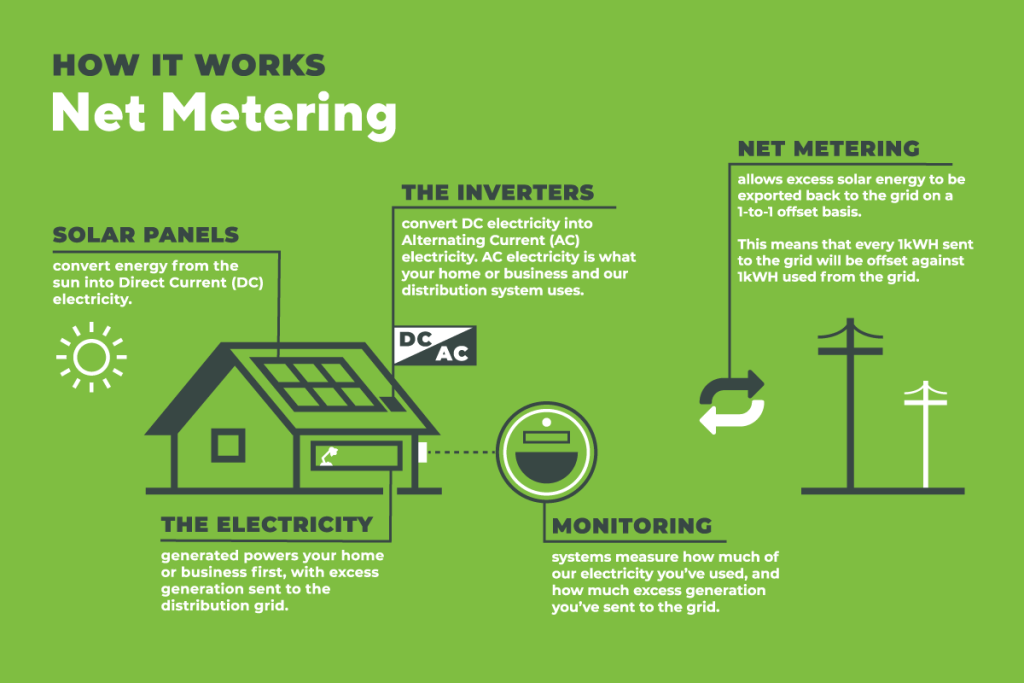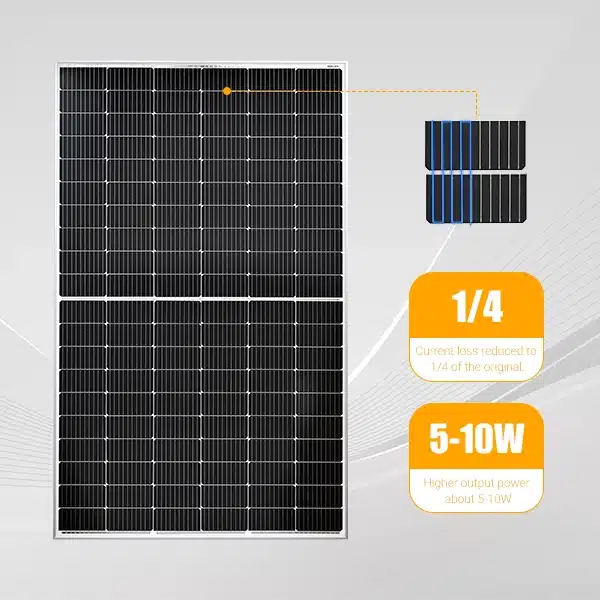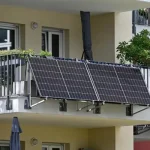With the shift in Net Metering policies, the residential solar market is undergoing significant changes. In the second quarter alone, residential solar installations reached 1.1 gigawatts DC, marking a 10% quarter-over-quarter decrease and a 37% year-over-year decline. This downward trend is particularly evident in California, where solar installations dropped by 36% during the transition to new net metering policies in the second quarter compared to the first quarter. These figures reflect the profound impact of policy adjustments on the solar market and highlight the importance of understanding how net metering and solar systems operate.
In today’s wave of energy transition, solar panels and net metering (Net Metering) have emerged as the two core themes driving the adoption of renewable energy in households. Solar panels capture sunlight and convert it into electricity for home use, while net metering provides economic compensation to households that generate excess electricity and feed it back into the grid. The combination of these two not only enhances a household’s energy autonomy but also brings significant economic and environmental benefits to users. This article will delve into the workings of solar panels and net metering, focusing on the multiple advantages they offer to homeowners.
This article aims to help readers fully understand how solar panels and net metering work together to maximize household energy efficiency and achieve economic savings. Through clear diagrams and detailed explanations, readers will learn:
- The basic working principles and components of solar panels
- The mechanism of net metering and its impact on household electricity bills
- The various economic and environmental advantages of adopting home solar systems
- How to optimize the installation and use of solar systems to maximize benefits
Whether you are a potential user considering the installation of a solar system or a homeowner looking to gain a deeper understanding of renewable energy solutions, this guide will provide you with valuable insights and practical advice to help you make informed decisions in the wave of energy transition.
Understanding Net Metering
Net metering is an electricity billing arrangement allowing homeowners with solar panels to send excess electricity back to the grid and receive credits on their utility bills. Essentially, when your solar system generates more electricity than your household consumes, the surplus energy is exported to the grid, and you earn corresponding credits. This system not only helps reduce your electricity bills but also supports the broader adoption of renewable energy sources.
How Net Metering Works
Net metering operates through a bi-directional meter that tracks both the electricity you consume from the grid and the excess electricity your solar panels produce and send back. During periods when your solar panels generate more power than you use, the surplus energy flows to the grid, and the meter records this contribution. At the end of the billing cycle, your utility company calculates your net electricity usage by subtracting the excess energy you provided from the total electricity you consumed. If you generate more energy than you used, you receive credits that can offset future electricity bills.
Importance of Net Metering
Net metering is crucial for maximizing the benefits of solar energy for homeowners. It enhances the economic viability of installing solar panels by providing financial incentives through bill credits, thereby improving the return on investment (ROI) for solar systems. Additionally, net metering promotes the use of renewable energy, contributing to environmental sustainability by reducing reliance on fossil fuels and lowering greenhouse gas emissions. Furthermore, by enabling distributed energy generation, net metering supports grid stability and resilience, especially during peak demand periods. Overall, net metering plays a vital role in encouraging more households to adopt solar energy, fostering both economic and environmental advantages.
How Solar Panels Work
Solar panels convert sunlight into electricity through the photovoltaic effect. When sunlight strikes the photovoltaic materials (typically silicon) in the solar panels, the energy from the photons dislodges electrons from atoms, creating an electric current. This process generates clean, renewable power while reducing reliance on traditional fossil fuels, thereby lowering carbon emissions.
Components of a Solar System
A complete solar system consists of several key components, including:
- Solar Panels: Capture sunlight and convert it into direct current (DC) electricity.
- Inverter: Transforms DC electricity into alternating current (AC) electricity for home use or to feed back into the grid.
- Mounting System: Secures and supports the solar panels, ensuring they are positioned at the optimal angle and orientation to maximize sunlight absorption.
- Battery Storage System (Optional): Stores excess electricity for use during periods of low sunlight, enhancing energy self-sufficiency.
- Monitoring System: Tracks the performance of the solar system in real-time, ensuring it operates efficiently.
Installation Process
Installing a solar system typically involves the following steps:
- Assessment and Design: Professionals evaluate your roof structure, sunlight exposure, and energy needs to design the most suitable solar system.
- Permitting and Approval: Obtain necessary building and electrical permits to ensure the installation complies with local regulations and standards.
- Equipment Installation: Install the mounting system, solar panels, inverter, and other components, ensuring the system is securely and safely affixed to the roof or designated location.
- Electrical Connection: Connect the solar system to the home’s electrical system and the grid, installing a bi-directional meter to facilitate net metering.
- System Testing and Activation: After installation, perform system tests to ensure all components are functioning correctly before officially activating the solar system.
- Maintenance and Monitoring: Regularly inspect and maintain the system, using the monitoring system to track its performance and ensure long-term efficiency.
By understanding the basic functionality of solar panels, the key components of a solar system, and the installation process, homeowners can better prepare and optimize their solar investments, achieving maximum energy and economic benefits.
How Solar and Net Metering Work Together
To effectively grasp the synergy between solar panels and net metering, a visual representation can be incredibly helpful. The following diagram serves as a visual aid, illustrating the flow of electricity within a home solar system integrated with net metering. This diagram highlights how energy is generated, consumed, and credited, providing a clear overview of the entire process.

Step 1: Solar Panel Installation
Solar panels are installed on the homeowner’s property, typically on the roof, to capture sunlight. The installation process involves mounting the panels at an optimal angle and orientation to maximize sunlight exposure throughout the day. Professional installers assess the property to determine the best placement for efficiency and aesthetics.
Step 2: Energy Generation
During daylight hours, the solar panels convert sunlight into direct current (DC) electricity through the photovoltaic effect. This generated electricity is then sent to an inverter, which transforms it into alternating current (AC) electricity suitable for household use. The energy generated is primarily used to power the home’s electrical appliances and systems.
Step 3: Energy Consumption
The electricity produced by the solar panels first meets the household’s immediate energy needs. This reduces the amount of electricity that needs to be drawn from the grid, thereby lowering the homeowner’s utility bills. Efficient energy management ensures that the majority of generated power is utilized effectively within the home.
Step 4: Excess Energy to Grid
If the solar system generates more electricity than the household consumes, the surplus energy is fed back into the electrical grid. This excess energy is then available for use by other consumers and contributes to the overall energy supply. Feeding excess energy back to the grid ensures that no generated power is wasted and supports the community’s energy needs.
Step 5: Bi-Directional Metering
A special bi-directional meter is installed to track both the electricity consumed from the grid and the excess electricity fed back. This meter accurately records the flow of electricity in both directions, ensuring precise measurement for billing purposes. The data collected by the bi-directional meter is essential for calculating net energy usage.
Step 6: Billing and Credits
At the end of each billing cycle, the utility company calculates the net electricity usage by subtracting the excess energy fed back into the grid from the total electricity consumed from the grid. If the homeowner has generated more energy than consumed, they receive credits or compensation based on local net metering policies. These credits can be applied to future electricity bills, effectively reducing the homeowner’s overall energy costs.
By understanding how solar panels and net metering work together through this diagrammatic explanation, homeowners can visualize the entire process of energy generation, consumption, and crediting. This comprehensive overview underscores the benefits of integrating solar systems with net metering, highlighting the economic and environmental advantages of adopting home solar energy solutions.
Benefits of Home Solar Systems with Net Metering
Adopting a solar system combined with net metering offers homeowners a multitude of advantages. Below, we delve into these benefits, encompassing economic savings, environmental protection, energy independence, and more.
Significant Cost Savings
By generating their own electricity, homeowners can substantially reduce their reliance on grid-purchased power, thereby lowering their monthly electricity bills. During daylight hours, the electricity produced by the solar system is first used to meet the household’s immediate energy needs. When the generation exceeds consumption, the surplus electricity is fed back into the grid. Through the net metering mechanism, users receive corresponding credits on their electricity bills. These credits can offset future energy costs, further decreasing overall energy expenses. Additionally, as solar technology advances and costs decrease, the return on investment (ROI) for solar systems continues to improve, making solar installations an economically viable long-term investment.
Environmental Impact
Solar energy is a clean and renewable resource, and using solar systems significantly reduces a household’s carbon footprint and dependence on fossil fuels. By lowering greenhouse gas emissions, solar power generation helps mitigate climate change and promotes environmental sustainability. Furthermore, the use of solar systems decreases air pollution and conserves water resources, contributing positively to the protection of ecological environments. The collective shift to solar energy at the household level has a profound global impact on environmental conservation efforts.
Energy Independence and Security
Installing a solar system grants households a degree of energy independence, reducing their reliance on traditional power grids. This not only enhances energy security but also protects homeowners from the uncertainties associated with fluctuating energy prices. During peak electricity demand periods or grid outages, households with self-generated power can continue to access electricity, thereby increasing overall energy resilience and security.
Increased Property Value
Studies have shown that homes equipped with solar systems are more attractive in the real estate market, with property values significantly increasing. Potential buyers are willing to pay a premium for homes that offer lower electricity bills and sustainable living features. Additionally, the presence of a solar system can shorten the time a property stays on the market, making solar-equipped homes more competitive. This not only provides economic benefits to current homeowners but also enhances the market value of properties for future resale.
Government Incentives and Rebates
Many governments offer various incentives, tax credits, and rebates to encourage households to install solar systems. These financial incentives significantly reduce the initial investment costs, making solar installations more affordable for a broader range of homeowners. For instance, in some countries and regions, users can take advantage of federal tax credits, local government rebates, and low-interest financing options. These incentives not only accelerate the adoption of solar systems but also enhance their economic feasibility.
Low Maintenance and Long Lifespan
Solar systems are renowned for their durability and minimal maintenance requirements. Most solar panels come with warranties that guarantee performance for 20-25 years, ensuring long-term reliability. Compared to traditional power generation equipment, solar systems have lower maintenance costs, typically requiring only regular cleaning and inspections. Moreover, ongoing improvements in solar panel materials and manufacturing processes enable solar systems to operate efficiently under various climatic conditions, further extending their lifespan.
Positive Community Impact
The widespread adoption of solar systems benefits not only individual households but also entire communities. Distributed generation reduces the overall demand on centralized power grids, enhancing grid stability and efficiency. When multiple households in a community utilize solar power, it creates larger energy clusters that promote energy sharing and resource optimization. Additionally, the proliferation of solar systems stimulates the local green economy, creates job opportunities, and elevates the community’s sustainability standards.

Maximizing the Benefits of Solar and Net Metering
To fully leverage the advantages of solar energy and net metering, homeowners can adopt several strategies that optimize system performance and enhance overall benefits. Here are some key methods to help you maximize the return on your solar investment and ensure efficient energy use:
Optimize Solar Panel Placement
Proper placement of solar panels is crucial for maximizing sunlight exposure and, consequently, energy generation. Ensure that your panels are oriented to face the optimal direction (typically south-facing in the Northern Hemisphere) and are tilted at an angle that captures the most sunlight throughout the year. Avoiding shading from trees, buildings, or other obstructions can significantly enhance the efficiency of your solar system. Additionally, consider using solar tracking systems that adjust the panels’ position to follow the sun’s path, further increasing energy capture.
Monitor Energy Consumption
Enhancing the benefits of your solar system involves not only generating electricity but also using it efficiently. Implementing energy-efficient practices can complement solar generation and lead to greater savings. Invest in energy-efficient appliances, utilize smart thermostats to optimize heating and cooling, and switch to LED lighting to reduce overall electricity consumption. Additionally, using energy monitoring tools can help you track your usage patterns, identify high-consumption areas, and make informed decisions to further decrease your energy demand.
Stay Informed About Local Policies
Net metering policies and incentives can vary significantly by region, impacting the financial benefits of your solar system. Staying informed about local regulations and available incentives is essential for maximizing your investment. Research the specific net metering rules in your area, including compensation rates and any system size limitations. Additionally, take advantage of government incentives such as tax credits, rebates, and grants that can reduce the initial cost of solar installations. Keeping abreast of policy changes ensures that you can adapt your energy strategy to take full advantage of available benefits.
Invest in Energy Storage Solutions
Pairing your solar system with energy storage solutions, such as batteries, can significantly enhance energy independence and maximize the utility of your solar generation. Energy storage allows you to store excess electricity generated during the day for use during nighttime or cloudy days, ensuring a continuous power supply and reducing reliance on the grid. This not only provides greater energy security but also enables load shifting, where you can use stored energy during peak demand periods to avoid higher electricity rates. Investing in battery storage can improve the overall efficiency and return on investment of your solar system.
Maximizing the Benefits of Solar and Net Metering
To fully leverage the advantages of solar energy and net metering, homeowners can adopt several strategies that optimize system performance and enhance overall benefits. Implementing these strategies not only maximizes the return on solar investments but also ensures efficient and sustainable energy use.
Optimize Solar Panel Placement
Proper placement of solar panels is crucial for maximizing sunlight exposure and, consequently, energy generation. Here are some tips to ensure your panels are positioned optimally:
Optimal Orientation and Tilt: In the Northern Hemisphere, solar panels should ideally face true south to capture the most sunlight throughout the day. In the Southern Hemisphere, a north-facing orientation is preferable. The tilt angle should be adjusted to match your geographic latitude, which helps in capturing maximum sunlight during different seasons.
Avoid Shading: Ensure that panels are free from obstructions such as trees, buildings, or other structures that can cast shadows and reduce efficiency. Regularly trim nearby trees and remove any potential shading sources to maintain optimal panel performance. Sungold anti-shade solar panels reduce power loss due to localized shading.
Height and Spacing: Install panels at a height that minimizes shading from nearby objects and provides adequate spacing between panels to allow for air circulation, which helps in cooling and maintaining efficiency.
Use of Tracking Systems: Consider using solar tracking systems that automatically adjust the panels’ position to follow the sun’s path. This can significantly increase energy capture throughout the day, especially in regions with high solar insolation.
Monitor Energy Consumption
Enhancing the benefits of your solar system involves not only generating electricity but also using it efficiently. Implementing energy-efficient practices can complement solar generation and lead to greater savings:
Energy-Efficient Appliances: Invest in appliances with high energy-efficiency ratings (e.g., ENERGY STAR certified) to reduce overall electricity consumption. Energy-efficient refrigerators, washing machines, and HVAC systems can significantly lower your energy demand.
Smart Thermostats: Use smart thermostats to optimize heating and cooling systems, ensuring they operate only when necessary. These devices can learn your usage patterns and adjust temperatures accordingly, reducing unnecessary energy use.
LED Lighting: Replace traditional incandescent bulbs with LED lighting, which consumes significantly less energy and has a longer lifespan. LED bulbs are more efficient and produce less heat, contributing to overall energy savings.
Insulation and Sealing: Improve your home’s insulation and seal gaps to minimize energy loss. Proper insulation reduces the need for heating and cooling, thereby decreasing the overall energy demand.
Energy Monitoring Systems: Utilize energy monitoring tools to track your electricity usage in real-time. Identifying high-consumption areas allows you to make informed decisions about where to cut back and implement additional energy-saving measures.
Stay Informed About Local Policies
Net metering policies and incentives can vary significantly by region, impacting the financial benefits of your solar system. Staying informed about local regulations and available incentives is essential for maximizing your investment:
Understand Net Metering Rules: Familiarize yourself with how net metering operates in your area, including compensation rates, billing cycles, and any caps on system sizes. Understanding these rules helps you predict the financial returns from your solar investment accurately.
Incentive Programs: Research available federal, state, and local incentives such as tax credits, rebates, and grants that can reduce the initial cost of solar installations. Programs like the Federal Investment Tax Credit (ITC) in the United States offer significant savings for solar adopters.
Regulatory Changes: Keep abreast of any changes in energy policies or net metering regulations that could affect your solar system’s performance and financial returns. Policy adjustments can influence compensation rates and the overall attractiveness of solar investments.
Utility Company Programs: Some utility companies offer additional programs or incentives for solar users, such as performance-based incentives or special rate plans. Contact your utility provider to explore all available options.
Community Resources: Engage with local renewable energy organizations or online forums to stay updated on best practices and policy developments related to solar energy. These resources can provide valuable insights and support for optimizing your solar setup.
Challenges and Considerations
While solar and net metering systems offer numerous benefits, there are also challenges and considerations that homeowners should be aware of before making an investment. Understanding these factors can help in making informed decisions and mitigating potential obstacles.
a. Policy Variability
Net metering policies can vary significantly by region, affecting the benefits and feasibility of solar installations:
Regional Differences: Each state or country may have its own net metering regulations, including differences in compensation rates, billing structures, and eligibility criteria. These variations can impact the financial returns of solar investments.
Changing Regulations: Energy policies are subject to change due to political shifts, economic considerations, or advancements in technology. Frequent changes in net metering policies can create uncertainty for homeowners considering solar installations.
Policy Caps: Some regions impose caps on the total amount of solar energy that can be fed back into the grid through net metering. Once these caps are reached, additional solar installations may receive reduced benefits or be excluded from net metering programs.
Tiered Rates: In some areas, net metering compensation rates may decrease as more solar capacity is added to the grid. This tiered approach can affect the long-term financial viability of larger solar systems.
b. Initial Investment Costs
The upfront costs of installing solar panels and related equipment can be a significant barrier for many homeowners:
High Initial Costs: Purchasing and installing solar panels, inverters, mounting systems, and optional battery storage can require a substantial initial investment. Although costs have decreased over the years, they remain a major consideration.
Financing Options: Homeowners may need to explore financing options such as loans, leases, or power purchase agreements (PPAs) to manage the upfront costs. Each option has its own terms, benefits, and drawbacks, which can affect the overall financial benefits of the solar system.
Payback Period: The time it takes to recoup the initial investment through energy savings and net metering credits can vary based on factors like system size, energy consumption, and local electricity rates. A longer payback period may deter some homeowners from pursuing solar installations.
c. Grid Infrastructure
The integration of increased distributed generation from solar systems poses challenges for existing grid infrastructure:
Capacity Limits: Traditional electrical grids were designed for unidirectional power flow, from centralized power plants to consumers. The addition of numerous distributed solar systems requires upgrades to handle bidirectional energy flows efficiently.
Grid Stability: High levels of solar penetration can affect grid stability, especially during periods of low demand or high generation. Utilities may need to implement advanced grid management technologies to maintain reliability and prevent outages.
Interconnection Standards: Connecting solar systems to the grid requires compliance with specific technical standards and regulations. Ensuring compatibility between solar installations and the grid infrastructure is essential for smooth operation.
Understanding these challenges and considerations is crucial for homeowners to make informed decisions about adopting solar and net metering systems. By being aware of policy variability, initial investment costs, grid infrastructure requirements, and utility company concerns, homeowners can better navigate the complexities of solar energy adoption and maximize the benefits of their solar investments.
Sungold SGM Series Rigid Solar Panels – The Ideal Home Solar Solution
When choosing a home solar system, the Sungold SGM Series Rigid Solar Panels stand out as an exceptional option due to their advanced technology and robust design. These panels utilize high-efficiency monocrystalline solar cells, ensuring maximum energy output and superior performance even in limited sunlight conditions. Their stable and reliable energy output makes them perfect for long-term residential use, while the long lifespan guarantees enduring performance and a strong return on investment.
Designed to withstand harsh weather, the SGM series boasts strong impact resistance, capable of handling up to 5400 Pa of snow load and 2400 Pa of wind load, making them ideal for various climates. With an IP67 waterproof rating, these panels are fully protected against dust and water ingress, ensuring consistent performance in diverse weather conditions. Installation is effortless thanks to the specialized mounting brackets, allowing for secure and easy setup on different roof types.
Additionally, the SGM Series has passed rigorous IEC 61215 standards, including flammability and fire resistance tests, underscoring their high quality and safety. Their compact design allows for more panels to be installed on a given roof area, maximizing energy production without compromising space. Economically, the SGM series offers cost-effective pricing combined with high durability, making them a smart investment for homeowners seeking to reduce energy costs and enhance property value.
Whether for traditional rooftop installations, RVs, campers, cabins, boats, or home backup power systems, the Sungold SGM Series Rigid Solar Panels provide a versatile and efficient photovoltaic solution. Embrace the reliability and performance of the SGM series to achieve energy independence, significant cost savings, and a sustainable future for your home.
Conclusion
Combining solar panels with net metering offers homeowners a multitude of benefits, including significant cost savings, environmental protection, energy independence, increased property value, access to government incentives, low maintenance requirements, and positive community impacts. These advantages make solar energy a compelling choice for those looking to reduce their energy bills and contribute to a sustainable future.
As the world continues to move towards renewable energy solutions, now is the perfect time to consider installing a solar system and taking advantage of net metering policies. Homeowners interested in reducing their energy costs, enhancing their property value, and making a positive impact on the environment should explore solar energy options. To get started, consult with a reputable solar provider, evaluate available incentives and financing options, and assess your home’s solar potential. Embrace the benefits of solar and net metering today and contribute to a greener, more sustainable energy landscape.
Disclaimer: All information provided in this article is sourced from the internet. For detailed policy explanations and personalized advice, please refer to official sources or consult with a professional.



.jpg)






